Foreign Insulators
by Marilyn Albers
Reprinted from "Crown Jewels of the Wire", April 1999, page 24
New CD 589
A TREASURED BEAUTY FROM THE UKRAINE
The owner of this insulator is Quenton Marty of Minneapolis, Minnesota. His
parents live in the Ukraine and since Quenton is a relatively new collector, he
asked them to try and find some insulators for him. That request certainly paid
off because they chose the best place to look - a sort of run down flea market -
and as luck would have it, they were able to buy two unique glass insulators for
only five grievnas, which Quenton says is equivalent to $2.00 American money.
One was a CD 540 in dark green, which has already been published in N.R.
Woodward's Consolidated Design Chart, and a very interesting new discovery in
bright green glass.
Quenton agreed to let me borrow this new style so I could
make a shadow profile and record measurements. When it arrived, everything
sensible that I should be doing came to a halt! It was so different from any
other foreign insulator I'd seen that I just couldn't take my eyes away from it.
Woody was able to get a good look at it too and was fascinated with every
detail. He has since classified this piece as new CD 589.
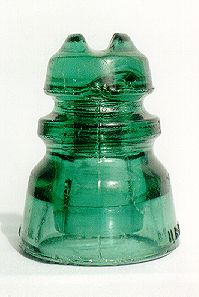
"CD 589 - Front view"
|
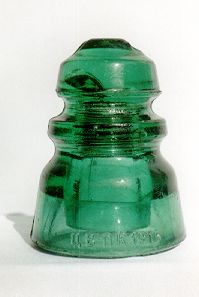
"Side view"
|
"Base rim with drip points"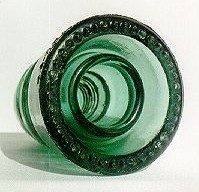 |
The insulator measures 4-5/8" in height and has a base diameter of
3-3/8". It has an inner skirt, the 1" pin hole is lined with 4 mm
(European) threads, and there are 39 sharp drips on the base rim! Embossed low
on the front skirt are the Russian letters and numbers "V.B.-n.K.
1916"
with "n.o." on the opposite side. Woody translated these figures into
the English sound and came up with "TZ.V.-P.K. 1916" and "L.O."
He has no idea of their meaning except for the 1916, which is probably a date.
He went on to
say that "the most interesting feature of this insulator is its similarity
to Hemingray. The mold characteristics and the base rim with 39 drips are
typical of Hemingray insulators. The mold engraving is not right for 1916 at
Muncie, but if the insulator was made there for export, the engraving would not
have been available using the style of that period. However, the engraving does
match Hemingray from 15-20 years earlier. This is not meant to suggest that this
is a Hemingray product, but it is probably the most interesting insulator to
make an appearance in some time!"
Quenton, many thanks for sharing this
wonderful insulator with all of our Crown Jewels of the Wire readers. You have a
very special treasure there, so wrap it in cotton and love it!
A REAL STROKE OF LUCK
In mid January of this year, Rob Johnson of East Hartford, CT, found an unlisted foreign glass insulator at a bottle show and wrote to me
asking for some information on it. Included in with his letter was all the basic
information I needed to see, in case this insulator should prove to be a new
find. He went to great lengths to describe the double grooved style, the ISOREX
embossing, the height, the base diameter, and the color of glass. He also sent
several shadow drawings with measurements and had sketched in some cosmetic
details that the shadow could not possibly show, as well as foil rubbings of the
exact embossing and the threads in the pin hole! I was very impressed that he
had gone to all that trouble to learn something about the insulator he had
acquired.
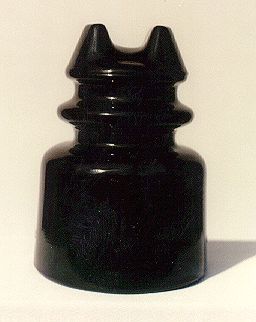
"New CD 587.4"
As it turned out, it is definitely a new find and Woody has classified it as
new CD 587.4. "ISOREX" is embossed on one side of the skirt with
"2352" on the opposite side. The insulator is 5-7/8" tall and has
a 4-1/4" base diameter. The glass color is a lovely dark teal green. At this
time it's the only example known and believe me, it's a fine piece of glass! It
should be - it weighs just under 3 lbs.! The pictures he'd sent in his letter
were somewhat fuzzy so he agreed to let me borrow the insulator and take my own
photos for this article. The box in which he sent it was so well packed that
half way into it, he had written a note saying "Keep going - there really
is an insulator in here."
The photo on the next page shows the two sizes of
this particular style that have now been documented. On the left is the familiar
CD 587 (see page 117 in G.I.F.O.N.A) with embossing "ISOREX //
234.2". To the right is Rob's new find, CD 587.4 embossed "ISOREX //
2352" (note the absence of a period between "5" and
"2"). Both examples are made of dark teal green glass.
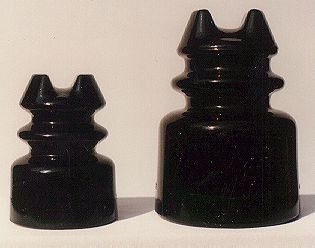
"What a pair!"
A PORCELAIN T-BAR WITH RAGLAN SLEEVES
So what is a raglan sleeve? It is a loose fitting sleeve that doesn't snug up under the arm pit. If you'll take a look
at the next photo, you'll see what I mean.
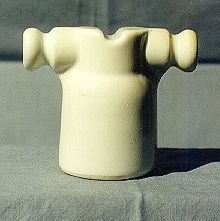
"No arm pits!"
This unmarked insulator belongs to
Eric Johnson of Stuart, Florida. It is made of white porcelain and very likely a
product of the Richard Ginori factory in Italy. It is 3-1/4" in height, it
has a base diameter of 2-1/4", and the arm span measures 3-7/8". Lacking
an inner skirt, this little fellow is unusually thick and sturdy.
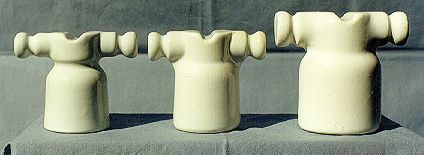
"Three different styles of Ginori T-bars"
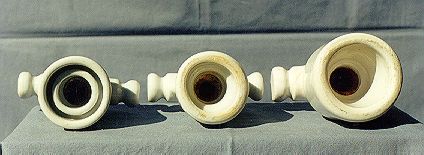
"Bottoms up"
On the left is just a plain ordinary T-bar made by Richard Ginori the kind
with an inner skirt that you are apt to see most frequently. It is approximately
3-1/4" in height. In the center is our Raglan lady, and to the right is the
taller and unusually broad T-bar that appeared in the June 1998 issue of Crown
Jewels of the Wire magazine and referred to as "Jack Sprat's wife who could
eat no lean." As you can see, this one doesn't have an inner skirt either.
I'm not sure, but I suspect that the two strange looking T-bars with thick
profiles were not adequately "trimmed" of excess porcelain while still
at the factory. On the other hand, it's possible they came out of a broader
thicker mold in order to create a very strong insulator. Jury's out so please
feel free to add your comments.
LOOK WHAT CAME OUT OF AUSTRIA!
I acquired this insulator in a, trade with Crown Jewels of the Wire
subscriber Frantisek Danek, who lives in the Czech Republic. Weighing in at 4-1/2
Ibs, this huge noser may claim the world's record for size! I've never seen one
so big. It is just under 6-1/4" in height, it has an inner skirt, and the
diameter of the base is 3-7/8". The horizontal span from the back of the
head to the tip of the slotted nose measures 5-1/4". Most certainly this
insulator was intended for use on high voltage power lines, and probably
descending ones. It has really been a conversation piece and I'm proud to have
it on my shelf.
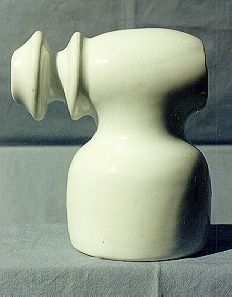
"World's largest porcelain Noser?"
"Oe.U.E.G. (over) S.150" is incused on the back side
of the insulator's head. These letters stand for "Oesterreichische Union
Eletrizitats Gesellschaft", or Austrian United Electric Company.
Frantisek's friend and mentor, Miroslav Immer of Prague, has a good command of
the English language as well as several others because he's been in the business
of buying and selling technical ceramics and insulators throughout Europe and
other countries since 1948. Thus he has always been willing and able to
translate foreign markings for me, including this one, and what a big help that
has been!
On the next page is a photo of two Austrian insulators. The smaller
insulator on the left has no marking but it is identical in style to the large
one, including the slotted nose. This one also came from Frantisek. I don't know
which one I wouldn't want! There was a time at the beginning of my collecting
years when I vowed I'd never collect porcelain insulators - only glass - but
then they slowly began to grow on me and that's okay because the combination of
both types has made my collection even more interesting.
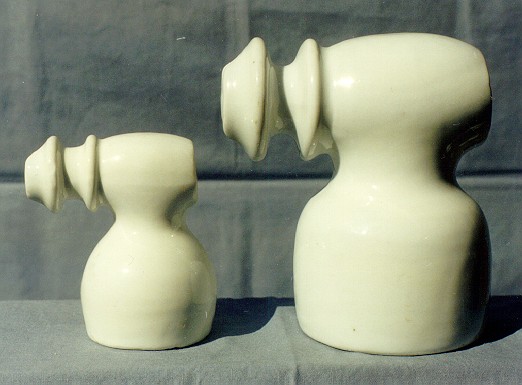
"Austrian Nosers in two sizes"
| 